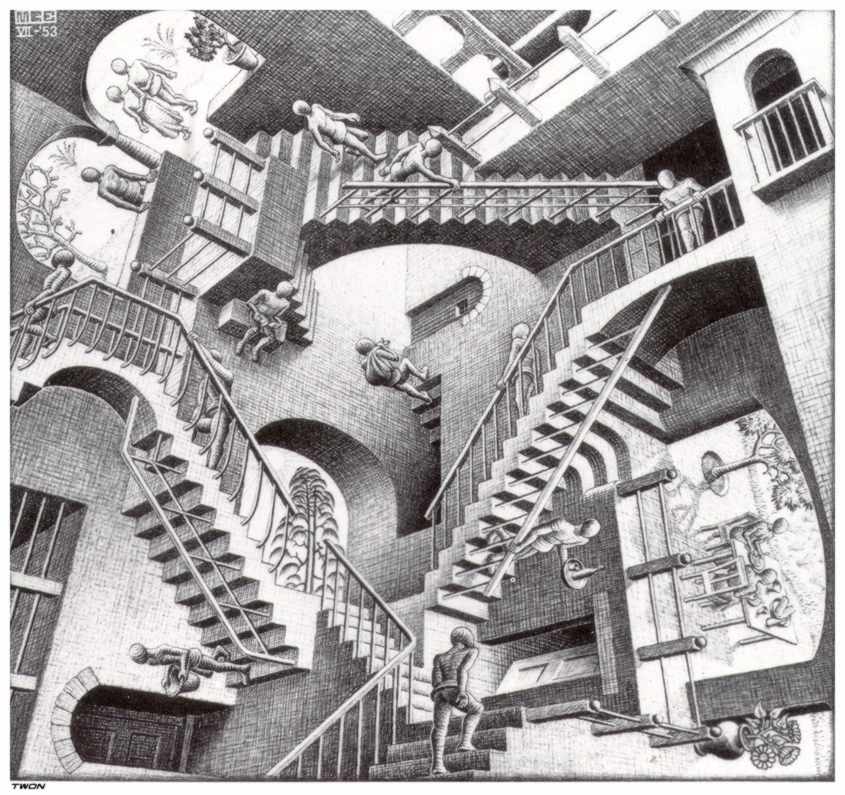Natasha Glydon
Art and Math may at first seem to be very differing things, but people who enjoy math tend to look for mathematics in art. They want to see the patterns and angles and lines of perspective. This is why artists like M.C. Escher appeal to mathematicians so much. There is a large amount of math involved in art, not to mention basic things like measuring and lines, but the intricacies of art can often be described using math.
Leonardo Da Vinci
One very famous piece, known as the Mona Lisa, painted by Leonardo Da Vinci, is drawn according to the golden ratio. The golden ratio is 1:0.618 and has been coined golden because it is said to be aesthetically pleasing. The golden proportion can be found throughout the human body. A golden rectangle is simply a rectangle with dimensions that reflect the golden ratio. The Mona Lisa has many golden rectangles throughout the painting. By drawing a rectangle around her face, we can see that it is indeed golden. If we divide that rectangle with a line drawn across her eyes, we get another golden rectangle, meaning that the proportion of her head length to her eyes is golden. There are other golden rectangles that can be drawn on the rest of her body, like from her neck to the top of her hands.
Da Vinci created other pieces that were also drawn according to the golden ratio such as The Last Supper, Old Man, and The Vitruvian Man. The Vitruvian Man (or Man in Action) is the drawing of a man inscribed in a circle. The height of the man is in golden proportion from the top of his head to his navel and from his navel to the bottom of his feet. The Vitruvian Man illustrates all of the divine proportions within the human being
M.C. Escher
Escher is a famous artist who created mathematically challenging artwork. He used only simple drawing tools and the naked eye, but was able to create stunning mathematical pieces. He focused on the division of the plane and played with impossible spaces. He produced polytypes, sometimes in drawings, which cannot be constructed in the real world, but can be described using mathematics. His drawings caught the eyes and looked possible by perception, but were mathematically impossible. His particular drawing, Ascending and Descending, which can be viewed at the M. C. Escher website, was one of these masterpieces. In this drawing, Escher creates a staircase that continues to ascend and descend, which is mathematically impossible, but the drawing makes it seem realistic. The following image, Relativity, is an example.
 M.C. Escher's "Relativity" (c) 2006 The M.C. Escher Company - the Netherlands. All rights reserved. Used by permission. http://www.mcescher.com |
Escher also created many interlocking figures that seemed mathematically incorrect. By using black and white, he was able to create different dimensions to make the mathematically impossible seem possible. Escher often combined two and three dimensional images into a single print, like his piece entitled Reptiles, where the reptiles themselves come out of a tessellation and walk around and then go back into the two dimensional picture.
To see more Escher pieces, visit www.mcescher.com.
Sometimes, artists want to create certain linear perspectives. In order to accomplish this, the artist will pick a point on the piece such that all the lines in the piece will come together at that single point. In this way, artists use math to create a certain perception for their audience, without any special mathematical tools. Many artists use math without realizing it. Escher didn’t use any mathematical tools while creating his pieces. In particular, his Circle Limit III contains tessellations that were drawn completely freehand and yet are mathematically correct to the millimeter.
An artist and business owner sent in a contruction problem to Math Central Quandaries and Queries. He wanted to contruct a three dimensional five pointed star. By visiting the page you can see the mathematical solution to this problem, as well as pictures of the finished product.
In art, mathematics is not always visible, unless you are looking for it. But there is much symmetry, geometry, and measurement involved in creating beautiful art. As well, many artists take advantage of mathematical findings, such as the golden ratio to make their artwork realistic and beautiful. Angles and perspective can also be described using math. Perhaps math and art are quite intricately linked.
